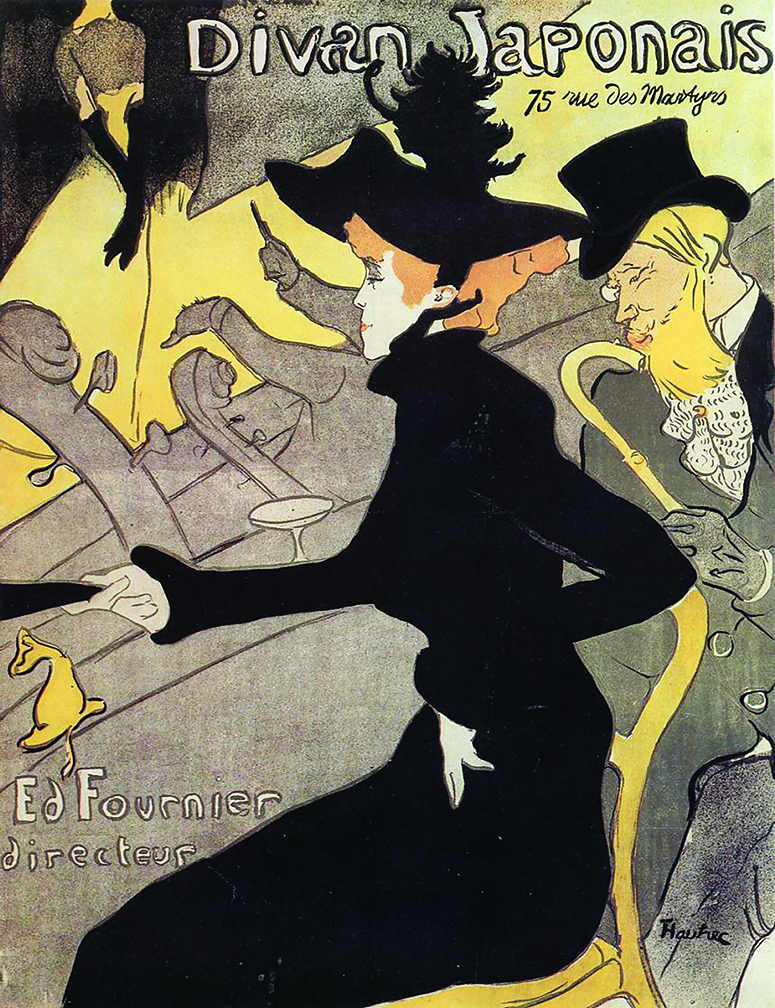
Divan Japonais
In 1882 at the age of 18, Henri de Toulouse-Lautrec moved from his family’s estate in southern France to Paris to study art and soon began to paint in the Impressionist style. He settled in Monmartre, the bohemian quarter of Paris at this time, where he frequented the café-concerts (cabarets) which became the subject of much of his work. He became famous in 1901 for the production of advertising posters which heralded a new aesthetic for affiches artistique (art posters). Lautrec’s sharp eye for design and color and his quick wit in depicting social depravity, together with recent developments of color lithography, elevated the print genre to fine art. Further, his eye for design was informed by Japanese art, as well as by photography, both of which were strong influences on art at that time. His work, displaying a keen affinity for the social underclass and a caricaturist’s eye on society, dominated affiche production until his untimely death in 1909 at the age of 36. He was an innovative print maker, including devising methods for "crachis" (a spatter effect which gives texture and depth to a color) and for making large prints on one piece of paper. He produced a total of 36 poster designs and 325 lithographs during his life.
Divan Japonais, an affiche artistique advertising the celebrated eponymous Monmartre cafe-concert, was displayed on buildings and fences throughout the streets of Paris. The lithograph was printed in four colors: olive (the keystone), red, yellow, and black. The gray tone of the middle ground is achieved by "crachis" or spatter effect. The design, influenced by Japanese woodblock ukiyo prints, is characterized by flat pictorial space and areas of pure color with sensuous outline. The print features three Paris nightlife celebrities amid the sexually charged gaiety of the pleasure quarter of Paris. As with the woodblock prints of Utamaro which celebrated individual, famed geishas of Edo's ukiyo (pleasure district), Lautrec focuses his attention on the Monmartre can-can dancer Jane Avril, while the singer Yvette Guilbert plays a cameo role in the scene. Jane Avril is portrayed as a spectator seated at the club's bar; the man whispering in her ear is the critic and bon vivant Edouard Dujardin; the performer on stage is the diseuse Yvette Guilbert, who half spoke, half sang her songs. We cannot see Guilbert’s face; but she is identified by her signature long, black gloves and her long, slim neck and torso. The bright orange fluff of Avril's hair under her characteristic frilly black hat provides a central focus, signals her vibrant personality, and enlivens the sense of fun in the risqué exchange between Avril and Dujardin. The acid yellow stage light provides an atmosphere of tension. In this narrative of loose, nightclub entertainment, the scene is filled with sexual innuendo: Dujardin, characterized by age lines around his eyes and a fleshy pink mouth, leans suggestively into Avril; Avril appears aloof, but amusement plays on her upturned, petal lips as her bright white hand points towards the center of her lap. The cabaret show joins in signaling sexual excitement: the erect necks of the basses extending up from the orchestra pit; the conductor's hands, one bent and one elongated through his baton; and Guilbert’s black, gloved arms held in a large V. In an era of recently loosened censorship laws, Lautrec's artful poster broadcasts the bawdy entertainments of the Monmartre quarter, converting the seedy into chic.

